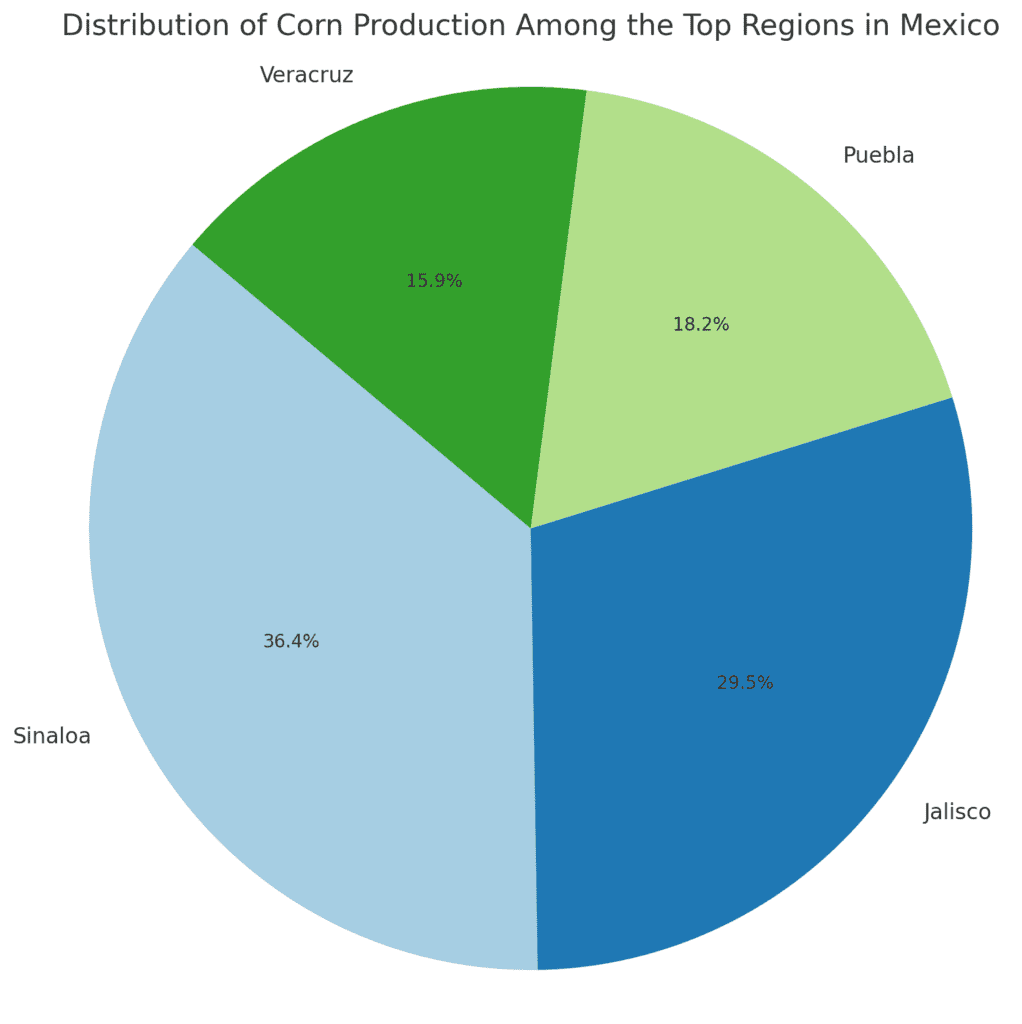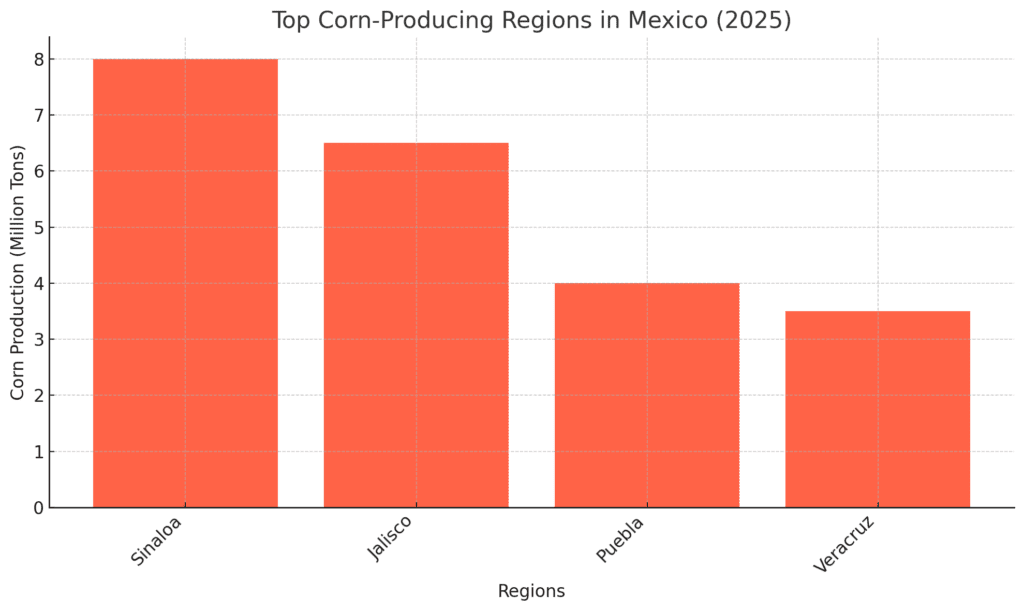Introduction
Mexico has a rich history tied to corn, known locally as maize. Corn is not only a staple food but also a symbol of Mexican culture and identity. The country has long been recognized as one of the top producers of maize in the world, with a production system that spans both large-scale commercial farming and smallholder agriculture. In this report, we will explore Mexico’s corn industry, the regions that lead production, the companies involved, and the challenges and opportunities the industry faces moving forward.
🚀 Supercharge Your Insights with ESS Pro
Access over 50,000 expert market reports and connect with more than 500,000 verified industry contacts across the global food & beverage value chain.
Includes exclusive insights, top 10 rankings, live market indicators, and up to 10 custom research reports annually.
🔓 Join ESS Pro – Unlock Full Access

The Importance of Corn in Mexico
Corn has been at the heart of Mexican agriculture for thousands of years. The crop is so central to the country that it’s often considered the country’s “national crop.” It’s used in a wide range of food products, such as tortillas, tamales, and snacks. Corn is not just a staple in the diet of Mexicans but also plays a role in the country’s economy, rural development, and agricultural practices. The production of maize in Mexico is vital for the nation’s food security, as well as its export economy.
Mexico is the world’s seventh-largest producer of maize, with over 25 million tons produced annually. The country also imports a significant amount of corn, mainly from the United States, to meet its internal demand. Despite its strong domestic production, Mexico faces challenges in terms of self-sufficiency and price volatility.
Key Corn-Producing Regions
Mexico’s diverse geography and climate allow for maize to be grown across different regions, each contributing significantly to the country’s overall maize production. The country’s main corn-producing regions are located in the central and southern parts of the country, where traditional maize farming has been a way of life for generations.
1. Sinaloa
Sinaloa is Mexico’s largest producer of maize. Located in the northwest part of the country, Sinaloa has extensive, fertile plains where corn is grown using advanced irrigation techniques. The region benefits from its mild climate and large-scale farming operations, which allow for higher yields. Corn produced in Sinaloa is mainly for the industrial food market, particularly for processed products like corn flour and snacks.
Sinaloa’s role in Mexico’s maize industry cannot be overstated. The region’s production contributes significantly to the country’s total maize output and its position as a major exporter of maize.
2. Jalisco
Jalisco, located in the western part of Mexico, is another key region for maize production. The state is known for its high-quality maize varieties, including both yellow and white corn, which are used for different purposes such as food, feed, and industrial processing. Jalisco’s maize farming practices often incorporate traditional techniques alongside modern farming methods, allowing the state to produce both large quantities and specialty corn products.
3. Puebla
Puebla, located in central Mexico, is another important maize-producing state. The region is known for its high-altitude areas, which provide optimal growing conditions for maize. Puebla produces a variety of maize, including some of the indigenous varieties that are unique to the region and are used in traditional Mexican cuisine. While its overall output is smaller than Sinaloa or Jalisco, Puebla plays an important role in preserving native maize varieties.
4. Veracruz
Veracruz, a coastal state in the Gulf of Mexico, is also a significant producer of maize. The region’s diverse climate, ranging from humid lowlands to cooler highlands, supports a variety of maize cultivation. Veracruz’s maize is used for both food and animal feed production, making it a critical contributor to Mexico’s agricultural sector.

Key Companies in Mexico’s Corn Industry
Several companies play a vital role in Mexico’s corn industry, from seed production to processing. These companies are not only involved in the supply chain of maize but also in advancing agricultural practices and ensuring food security.
1. Grupo Maseca (Gruma)
Grupo Maseca, the largest corn flour producer in Mexico and a key player globally, is a dominant force in the Mexican maize industry. The company produces a variety of corn-based products, including masa flour used for tortillas and tamales. Gruma, the parent company of Maseca, is one of the largest food companies in Mexico and has operations in several countries.
The company plays a crucial role in driving maize demand, both for domestic consumption and export. Maseca also supports local maize farmers through its extensive distribution and processing networks.
2. Alsea
Alsea is a major foodservice company in Mexico that plays a role in the maize industry through its production of corn-based fast food products, such as tacos, tortillas, and other Mexican food items. Alsea works with maize producers to ensure a steady supply of corn, which is essential for its restaurant chains.
While Alsea is not directly involved in maize farming, its significant demand for corn supports the overall maize market in Mexico.
3. BASF Mexico
BASF Mexico, a subsidiary of the global chemical giant BASF, is involved in providing seeds, fertilizers, and pesticides to maize farmers in Mexico. The company works to improve maize productivity and help farmers increase their yields. BASF’s research and development efforts focus on creating higher-yielding, pest-resistant corn varieties, contributing to the efficiency of the maize industry in Mexico.
Challenges and Opportunities
Mexico’s maize industry faces several challenges, including climate change, price volatility, and trade agreements with other countries. One of the primary concerns is the country’s reliance on imports to meet its growing demand for maize. While Mexico produces large quantities of maize, it still imports a significant amount, mainly from the U.S. to fill the gap in production. This dependence on imports exposes Mexico to price fluctuations and trade disruptions.
Another challenge is the ongoing issue of land degradation and water scarcity in some key maize-producing regions. The lack of irrigation in certain areas and the depletion of soil quality can affect overall yields, making it more difficult for farmers to maintain consistent production.
However, there are several opportunities for growth in Mexico’s maize industry. The increasing demand for maize in animal feed production, especially with Mexico’s growing livestock sector, provides a steady market for corn. Additionally, there is a push toward increasing maize self-sufficiency by investing in sustainable farming practices, water conservation, and agricultural technology. With the right support, Mexico’s maize industry has the potential to reduce its reliance on imports and increase production to meet both domestic and global needs.
Conclusion
Mexico’s corn industry is essential to the country’s economy and food culture. With key maize-producing regions like Sinaloa, Jalisco, and Puebla, and companies such as Grupo Maseca and BASF Mexico driving the sector forward, the country is poised to remain a global leader in maize production. However, challenges such as climate change, price volatility, and import reliance remain pressing issues. By focusing on sustainability and technological advancements, Mexico can continue to grow its maize industry, ensuring a stable supply for its people and its role in the global corn market.



